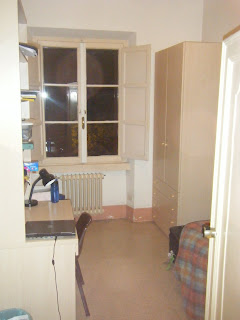 This is the building that you see upon getting off of the 44 bus in the Piazza de Venezia. Some call it an eyesore, but I think that its somewhat overly extravagant style has appeal. We then walked down the Via dei Fori Imperiali, a road built by Mussolini, eliminating the Velian hill, in order to create sight lines to the Colosseum. After following that road we reached the forum.
This is the building that you see upon getting off of the 44 bus in the Piazza de Venezia. Some call it an eyesore, but I think that its somewhat overly extravagant style has appeal. We then walked down the Via dei Fori Imperiali, a road built by Mussolini, eliminating the Velian hill, in order to create sight lines to the Colosseum. After following that road we reached the forum. Here is a view of the Capitoline from the East. Notice the arch of Septimius Severus (in the center) and the Curia Iulia (the square brick building to its right), both built over part of the comitium.
Here is a view of the Capitoline from the East. Notice the arch of Septimius Severus (in the center) and the Curia Iulia (the square brick building to its right), both built over part of the comitium.
We then climbed up and around to the top of the Palatine.

In front of the temple of Magna Mater, sits this archaeological site, the so-called "hut of Romulus." The huts themselves date to the 9th/8th centuries BC, yet, although they match the date of Rome's legendary king, it is almost certain that these were not the huts with which Romulus' cult was associated.


These two pictures show the "lacus curtius." The first is a copy of an ancient relief and the second a fountain or pool (although archaeology has shown that there was no water in it as early as the second century BC). The Romans connected this monument to a remarkable story, or rather, three.
1) Livy tells us that during the battle with the Sabines, Romulus routed Mettius Curtius, a Sabine general, and he fled into the swamp, where he drowned. After the forum was drained, this pool was left to commemorate the event.
2) Varro records that under a Roman consul named Curtius, this spot was struck with lightning and thus became sacred.
3) And finally, probably the most exciting story, is told again by Livy. In the fourth century, a chasm opened up in the forum and continued to grow larger. Out of fear, the Romans consulted the Sibylline oracles, and they learned that they must throw into the chasm that which Rome treasured most. The frightened Romans futilely threw in their wealth and jewelry; the chasm kept on growing. Finally, a brave Roman equestrian named Marcus Curtius solemnly armed himself for battle, mounted his horse, and bravely rode into the gap, sealing up the chasm. The moral is that it is not wealth but brave soldiers that Rome should treasure most dearly.
This is the Temple of Saturn, rebuilt in the 4th century AD by the senate after it was destroyed by a fire (which we know of from the inscription). Traditionally built first by Tullus Hostilius, the temple underwent several phases before the 4th century. As the class learned about the temple, the god, and Saturnalia, our professor had us all shout "io Saturnalia" - an attempt to recreate some of the liveliness of the ancient festival.
This is the Temple to Castor initially built after the Roman victory at Lake Regillus in 499 BC, where 2 youths (Castor and Pollux) supposedly appeared on white horses and saved the day. It was expanded in 117 BC and 6 AD. If you look closely at the picture you can see the 3 different phases.
This is the site of the mysterious lapis niger (black stone) which sat in the comitium. Although we could not see it due to ostensible archaeology, we did here a wonderful lecture on possible explanations for its existence. The large black stone sealed something in the 2nd century BC. Excavations have revealed a truncated altar, pedestal, and cippus with a fragmentary inscription. The first few lines read as follows:
"may the one who will violate this place be condemned to the gods of the underworld"
This could be the site of a number of things. A burial marker? A shrine? A geological anomaly? Some combination of the above? A UFO landing? Well the last one's a joke, but you get the idea.

On a side note, one of the foosball figures is painted black, so we have lovingly taken to calling him lapis niger. There are many fun ways in which lecture and reading materials are worked into our daily lives. It is exciting to have the chance to interact with other classics students and have a good time in Rome, both in and out of class.












